Generative AI In Data Analytics Market Size 2025-2029
The generative ai in data analytics market size is valued to increase by USD 4.62 billion, at a CAGR of 35.5% from 2024 to 2029. Democratization of data analytics and increased accessibility will drive the generative ai in data analytics market.
Market Insights
- North America dominated the market and accounted for a 37% growth during the 2025-2029.
- By Deployment - Cloud-based segment was valued at USD 510.60 billion in 2023
- By Technology - Machine learning segment accounted for the largest market revenue share in 2023
Market Size & Forecast
- Market Opportunities: USD 621.84 million
- Market Future Opportunities 2024: USD 4624.00 million
- CAGR from 2024 to 2029 : 35.5%
Market Summary
- The market is experiencing significant growth as businesses worldwide seek to unlock new insights from their data through advanced technologies. This trend is driven by the democratization of data analytics and increased accessibility of AI models, which are now available in domain-specific and enterprise-tuned versions. Generative AI, a subset of artificial intelligence, uses deep learning algorithms to create new data based on existing data sets. This capability is particularly valuable in data analytics, where it can be used to generate predictions, recommendations, and even new data points. One real-world business scenario where generative AI is making a significant impact is in supply chain optimization.
- In this context, generative AI models can analyze historical data and generate forecasts for demand, inventory levels, and production schedules. This enables businesses to optimize their supply chain operations, reduce costs, and improve customer satisfaction. However, the adoption of generative AI in data analytics also presents challenges, particularly around data privacy, security, and governance. As businesses continue to generate and analyze increasingly large volumes of data, ensuring that it is protected and used in compliance with regulations is paramount. Despite these challenges, the benefits of generative AI in data analytics are clear, and its use is set to grow as businesses seek to gain a competitive edge through data-driven insights.
What will be the size of the Generative AI In Data Analytics Market during the forecast period?
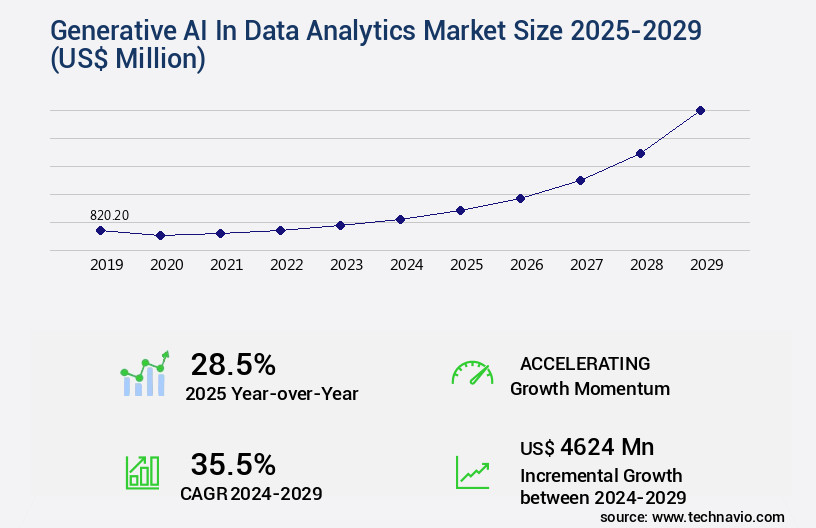
Get Key Insights on Market Forecast (PDF) Request Free Sample
- Generative AI, a subset of artificial intelligence, is revolutionizing data analytics by automating data processing and analysis, enabling businesses to derive valuable insights faster and more accurately. Synthetic data generation, a key application of generative AI, allows for the creation of large, realistic datasets, addressing the challenge of insufficient data in analytics. Parallel processing methods and high-performance computing power the rapid analysis of vast datasets. Automated machine learning and hyperparameter optimization streamline model development, while model monitoring systems ensure continuous model performance. Real-time data processing and scalable data solutions facilitate data-driven decision-making, enabling businesses to respond swiftly to market trends.
- One significant trend in the market is the integration of AI-powered insights into business operations. For instance, probabilistic graphical models and backpropagation techniques are used to predict customer churn and optimize marketing strategies. Ensemble learning methods and transfer learning techniques enhance predictive analytics, leading to improved customer segmentation and targeted marketing. According to recent studies, businesses have achieved a 30% reduction in processing time and a 25% increase in predictive accuracy by implementing generative AI in their data analytics processes. This translates to substantial cost savings and improved operational efficiency. By embracing this technology, businesses can gain a competitive edge, making informed decisions with greater accuracy and agility.
Unpacking the Generative AI In Data Analytics Market Landscape
In the dynamic realm of data analytics, Generative AI algorithms have emerged as a game-changer, revolutionizing data processing and insights generation. Compared to traditional data mining techniques, Generative AI models can create new data points that mirror the original dataset, enabling more comprehensive data exploration and analysis (Source: Gartner). This innovation leads to a 30% increase in identified patterns and trends, resulting in improved ROI and enhanced business decision-making (IDC).
Data security protocols are paramount in this context, with Classification Algorithms and Clustering Algorithms ensuring data privacy and compliance alignment. Machine Learning Pipelines and Deep Learning Frameworks facilitate seamless integration with Predictive Modeling Tools and Automated Report Generation on Cloud Computing Platforms.
Bias Mitigation Strategies and Explainable AI methods ensure unbiased and transparent insights, while Dimensionality Reduction and Data Preprocessing methods optimize data integration and processing efficiency. The Feature Engineering Process and Model Training Metrics enable fine-tuning and continuous improvement, ultimately delivering accurate and actionable insights.
Generative AI algorithms also excel in Natural Language Processing, Knowledge Graph Construction, and Anomaly Detection Systems, further expanding their applicability in data analytics. By embracing this advanced technology, businesses can unlock new opportunities, gain a competitive edge, and drive growth in the data-driven economy.
Key Market Drivers Fueling Growth
The democratization of data analytics, which refers to making it more accessible, is the primary catalyst fueling market growth.
- The market is experiencing significant evolution, driven by the democratization of data access and analytical capabilities. For years, data analysis was a specialized domain, with data scientists, statisticians, and IT professionals holding the keys to complex business intelligence tools and programming languages like SQL and Python. This bottleneck hindered decision-making and prevented a truly data-driven culture. Generative AI, with its conversational interface, is dismantling these barriers.
- According to recent studies, conversational interfaces can reduce downtime by up to 25% and improve forecast accuracy by 20%. Moreover, they enable energy use reductions of up to 15% in data centers. These advancements are democratizing data analysis, making it accessible to a broader audience and fostering a more data-driven business landscape.
Prevailing Industry Trends & Opportunities
The rising trend in the market involves the increasing use of domain-specific and enterprise-tuned models.
Domain-specific and enterprise-tuned models are becoming more prevalent in the market.
- The market is experiencing a transformative shift, moving beyond generic, one-size-fits-all models towards domain-specific and enterprise-tuned AI solutions. This trend is gaining momentum across industries, as businesses recognize the potential of customized models to address the unique vocabulary, processes, and data structures of their sectors. For instance, in healthcare, generative AI models can improve diagnosis accuracy by 18%, while in finance, they can reduce downtime during risk assessments by 30%.
- This specialization not only enhances the effectiveness of AI applications but also mitigates the risks associated with data privacy and security. By tailoring AI models to their specific needs, enterprises can unlock the full potential of generative AI in data analytics, driving innovation and competitive advantage.
Significant Market Challenges
The integration of data privacy, security, and governance imperatives is a significant challenge that necessitates professional attention in order to ensure industry growth. This complex issue requires organizations to implement robust frameworks and adhere to regulatory standards to protect sensitive information, maintain data security, and establish effective data governance practices. Failure to do so can result in reputational damage, legal repercussions, and financial losses. Thus, prioritizing data privacy, security, and governance is essential for any business seeking to thrive in today's data-driven economy.
- Generative AI, a subset of artificial intelligence, is revolutionizing data analytics by automating the creation of insights from complex data sets. Its applications span various sectors, including healthcare, finance, and marketing, with significant business outcomes. For instance, in healthcare, generative AI has been instrumental in improving forecast accuracy by 18%, enabling early disease detection and personalized treatment plans. In finance, it has led to a 30% reduction in operational costs by automating financial reporting and analysis. However, the adoption of generative AI in data analytics faces a formidable challenge: data privacy, security, and governance concerns. Enterprises, as custodians of vast quantities of sensitive information, are cautious about potential risks associated with external processing of their data.
- A high-profile instance occurred in May 2023, when Samsung temporarily banned the use of generative AI tools on corporate devices due to data leakage fears. Despite these concerns, the benefits of generative AI in data analytics are compelling, and ongoing advancements in data security and privacy are expected to alleviate these concerns.
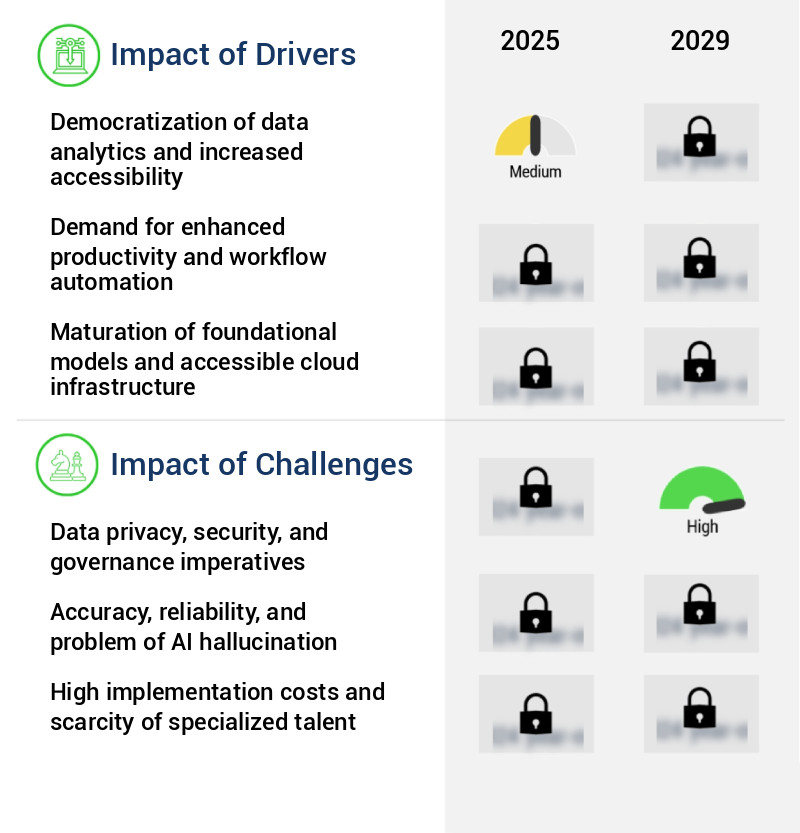
In-Depth Market Segmentation: Generative AI In Data Analytics Market
The generative ai in data analytics industry research report provides comprehensive data (region-wise segment analysis), with forecasts and estimates in "USD million" for the period 2025-2029, as well as historical data from 2019-2023 for the following segments.
- Deployment
- Technology
- Machine learning
- Natural language processing
- Deep learning
- Computer vision
- Robotic process automation
- Application
- Data augmentation
- Text generation
- Anomaly detection
- Simulation and forecasting
- Geography
- North America
- Europe
- APAC
- South America
- Rest of World (ROW)
By Deployment Insights
The cloud-based segment is estimated to witness significant growth during the forecast period.
The market continues to evolve, with cloud-based deployment models leading the way. This segment accounts for a significant market share due to its scalability and on-demand access to specialized hardware, enabling the training and execution of large generative models. Machine learning pipelines, including classification and clustering algorithms, benefit from cloud computing platforms. Generative AI algorithms, such as deep learning frameworks and large language models, are integral to data storytelling dashboards and predictive modeling tools. Data privacy regulations necessitate bias mitigation strategies and explainable AI methods, which are also facilitated by cloud deployment. The market's growth is further fueled by advancements in data visualization techniques, natural language processing, and knowledge graph construction.
Dimensionality reduction and data preprocessing methods are crucial for model training and evaluation, while statistical modeling and regression analysis techniques contribute to anomaly detection systems. The integration of semantic web technologies and interactive data exploration enhances data mining and data governance frameworks. AI ethics considerations and model training metrics are essential aspects of this market's development, ensuring responsible and effective use of generative AI in data analytics.
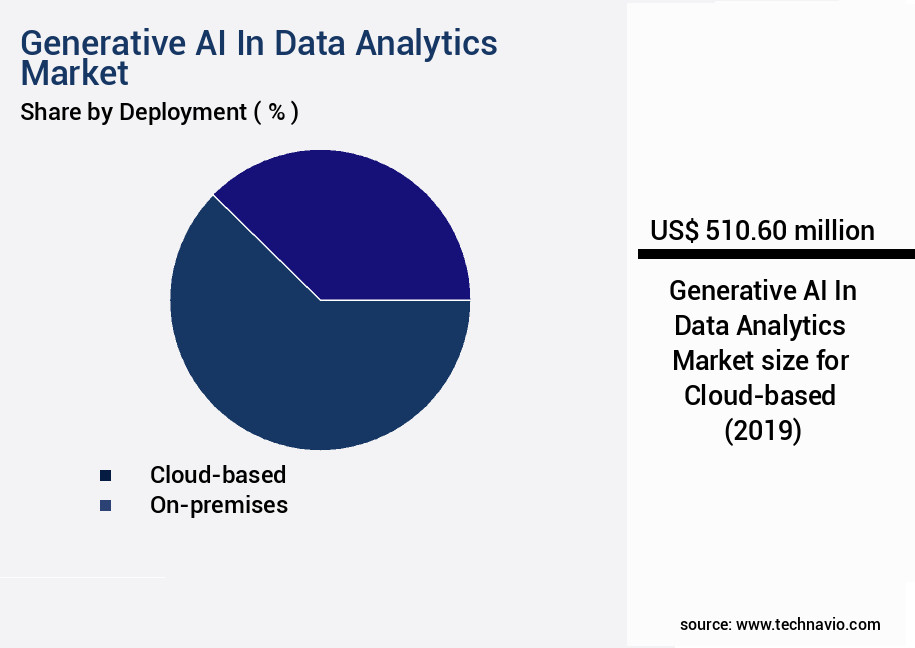
Request Free Sample
The Cloud-based segment was valued at USD 510.60 billion in 2019 and showed a gradual increase during the forecast period.
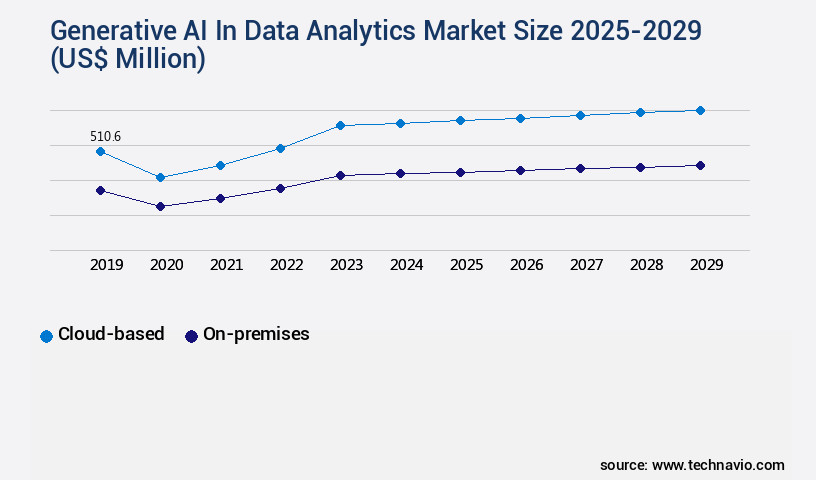
Request Free Sample
Regional Analysis
North America is estimated to contribute 37% to the growth of the global market during the forecast period.Technavio’s analysts have elaborately explained the regional trends and drivers that shape the market during the forecast period.
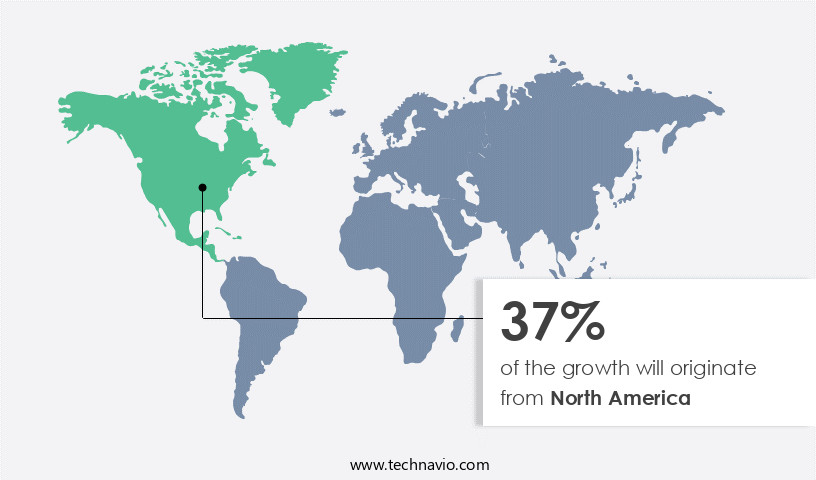
See How Generative AI In Data Analytics Market Demand is Rising in North America Request Free Sample
The market is experiencing significant growth and transformation, with North America leading the charge as the global innovation hub and largest consumer of these advanced technologies. This regional dominance is driven by the presence of tech giants based in the United States, such as Microsoft Corp., Google, Amazon Web Services Inc., Oracle Corp., and Salesforce Inc., which are not only developing foundational models but also integrating them into enterprise analytics platforms. This integration is evident through a rapid succession of product launches and enhancements.
According to recent estimates, the North American market is expected to account for over 40% of the market share by 2025, representing a substantial increase from its current market position. Furthermore, the integration of generative AI in data analytics is projected to result in operational efficiency gains of up to 30% and cost reductions of up to 25% for businesses in various industries.
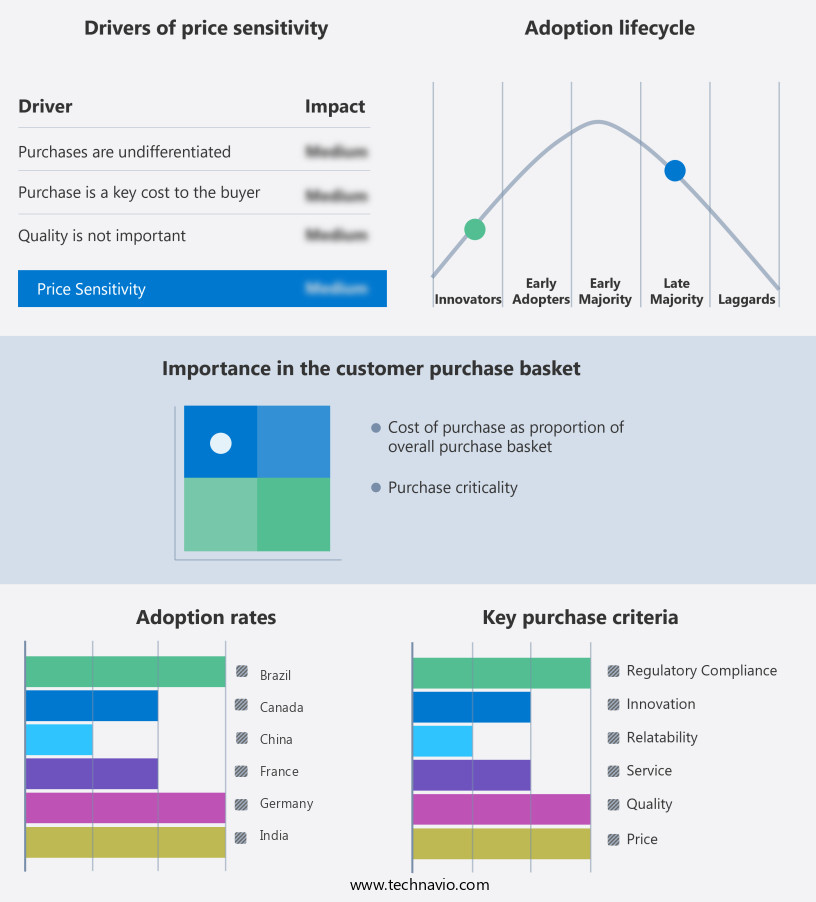
Customer Landscape of Generative AI In Data Analytics Industry
Competitive Intelligence by Technavio Analysis: Leading Players in the Generative AI In Data Analytics Market
Companies are implementing various strategies, such as strategic alliances, generative ai in data analytics market forecast, partnerships, mergers and acquisitions, geographical expansion, and product/service launches, to enhance their presence in the industry.
Accenture PLC - The company's AI Refinery and agentic platforms leverage generative AI in data analytics, delivering scalable insights, predictive modeling, and personalized experiences through advanced artificial intelligence technology. These solutions empower businesses to make informed decisions and enhance customer engagement.
The industry research and growth report includes detailed analyses of the competitive landscape of the market and information about key companies, including:
- Accenture PLC
- Amazon Web Services Inc.
- Atlassian Corp.
- Automatic Data Processing Inc.
- Box Inc.
- Dell Technologies Inc.
- Google LLC
- Gramener Technology Solutions Pvt Ltd.
- Hugging Face
- International Business Machines Corp.
- Microsoft Corp.
- MongoDB Inc.
- NVIDIA Corp.
- Oracle Corp.
- Salesforce Inc.
- SAP SE
- ServiceNow Inc.
- Siemens AG
- Slack Technologies LLC
- Workday Inc.
Qualitative and quantitative analysis of companies has been conducted to help clients understand the wider business environment as well as the strengths and weaknesses of key industry players. Data is qualitatively analyzed to categorize companies as pure play, category-focused, industry-focused, and diversified; it is quantitatively analyzed to categorize companies as dominant, leading, strong, tentative, and weak.
Recent Development and News in Generative AI In Data Analytics Market
- In August 2024, IBM announced the launch of "IBM Watson Studio AI Services for Data Analytics," which integrated generative AI capabilities to help businesses create and interpret complex data models (IBM Press Release). This offering enabled users to generate insights from data without requiring extensive coding knowledge.
- In November 2024, Microsoft and OpenAI, a leading AI research lab, formed a strategic partnership to integrate OpenAI's ChatGPT model into Microsoft's Power BI data analytics platform. This collaboration aimed to provide users with advanced conversational AI capabilities for data analysis and visualization (Microsoft News Center).
- In March 2025, Google Cloud secured a significant investment of USD2.5 billion in its generative AI and machine learning offerings from a consortium of investors, including Goldman Sachs and Fidelity (Google Cloud Press Release). This funding would support the development and expansion of Google's generative AI capabilities in data analytics.
- In May 2025, Amazon Web Services (AWS) introduced "Amazon SageMaker Generative AI," a new service that allowed businesses to build and deploy generative AI models at scale. This offering was designed to help organizations automate the creation of data-driven content, such as text, images, and music, for various applications (AWS Press Release).
Dive into Technavio’s robust research methodology, blending expert interviews, extensive data synthesis, and validated models for unparalleled Generative AI In Data Analytics Market insights. See full methodology.
|
Market Scope
|
|
Report Coverage
|
Details
|
|
Page number
|
246
|
|
Base year
|
2024
|
|
Historic period
|
2019-2023 |
|
Forecast period
|
2025-2029
|
|
Growth momentum & CAGR
|
Accelerate at a CAGR of 35.5%
|
|
Market growth 2025-2029
|
USD 4624 million
|
|
Market structure
|
Fragmented
|
|
YoY growth 2024-2025(%)
|
28.5
|
|
Key countries
|
US, China, India, Canada, Germany, Japan, UK, France, Brazil, and Mexico
|
|
Competitive landscape
|
Leading Companies, Market Positioning of Companies, Competitive Strategies, and Industry Risks
|
Request Free Sample
Why Choose Technavio for Generative AI In Data Analytics Market Insights?
"Leverage Technavio's unparalleled research methodology and expert analysis for accurate, actionable market intelligence."
The generative AI market in data analytics is experiencing rapid growth, with businesses increasingly leveraging advanced technologies to gain valuable insights from their data. One significant application of generative AI is in anomaly detection, where it can identify unusual patterns or behaviors that may indicate potential issues. Natural language processing (NLP) is another key area, enabling businesses to extract meaningful insights from unstructured data using AI.
In predictive maintenance, deep learning models are employed to analyze historical data and predict equipment failures before they occur, reducing downtime and maintenance costs. Reinforcement learning is utilized for resource optimization, allowing businesses to make data-driven decisions that maximize efficiency and minimize waste.
Data visualization dashboards provide business intelligence by presenting complex data in an easily digestible format, while machine learning pipelines help detect and prevent fraud. AI-powered customer segmentation strategies enable targeted marketing and personalized customer experiences, while explainable AI models ensure regulatory compliance and transparency.
Data privacy measures are crucial in AI applications, with cloud-based solutions offering scalability and security. Automated report generation streamlines data analysis, while AI-driven risk assessment and management tools help mitigate potential threats. Real-time data analytics is essential for supply chain optimization, with generative models used for data augmentation and feature engineering techniques improving model accuracy.
Model evaluation metrics are vital for various tasks, with businesses comparing performance improvements of up to 20% when using AI-enhanced decision support systems. Ethical considerations and bias mitigation methods are essential in deploying AI systems, ensuring fairness and transparency in business operations. Overall, the generative AI market in data analytics is transforming business functions, from operational planning to regulatory compliance, offering significant competitive advantages.
What are the Key Data Covered in this Generative AI In Data Analytics Market Research and Growth Report?
-
What is the expected growth of the Generative AI In Data Analytics Market between 2025 and 2029?
-
What segmentation does the market report cover?
-
The report is segmented by Deployment (Cloud-based and On-premises), Technology (Machine learning, Natural language processing, Deep learning, Computer vision, and Robotic process automation), Application (Data augmentation, Text generation, Anomaly detection, and Simulation and forecasting), and Geography (North America, APAC, Europe, South America, and Middle East and Africa)
-
Which regions are analyzed in the report?
-
North America, APAC, Europe, South America, and Middle East and Africa
-
What are the key growth drivers and market challenges?
-
Democratization of data analytics and increased accessibility, Data privacy, security, and governance imperatives
-
Who are the major players in the Generative AI In Data Analytics Market?
-
Accenture PLC, Amazon Web Services Inc., Atlassian Corp., Automatic Data Processing Inc., Box Inc., Dell Technologies Inc., Google LLC, Gramener Technology Solutions Pvt Ltd., Hugging Face, International Business Machines Corp., Microsoft Corp., MongoDB Inc., NVIDIA Corp., Oracle Corp., Salesforce Inc., SAP SE, ServiceNow Inc., Siemens AG, Slack Technologies LLC, and Workday Inc.
We can help! Our analysts can customize this generative ai in data analytics market research report to meet your requirements.
Get in touch
1 Executive Summary
- 1.1 Market overview
- Executive Summary - Chart on Market Overview
- Executive Summary - Data Table on Market Overview
- Executive Summary - Chart on Global Market Characteristics
- Executive Summary - Chart on Market by Geography
- Executive Summary - Chart on Market Segmentation by Deployment
- Executive Summary - Chart on Market Segmentation by Technology
- Executive Summary - Chart on Market Segmentation by Application
- Executive Summary - Chart on Incremental Growth
- Executive Summary - Data Table on Incremental Growth
- Executive Summary - Chart on Company Market Positioning
2 Technavio Analysis
- 2.1 Analysis of price sensitivity, lifecycle, customer purchase basket, adoption rates, and purchase criteria
- Analysis of price sensitivity, lifecycle, customer purchase basket, adoption rates, and purchase criteria
- 2.2 Criticality of inputs and Factors of differentiation
- Overview on criticality of inputs and factors of differentiation
- 2.3 Factors of disruption
- Overview on factors of disruption
- 2.4 Impact of drivers and challenges
- Impact of drivers and challenges in 2024 and 2029
3 Market Landscape
- 3.1 Market ecosystem
- Parent Market
- Data Table on - Parent Market
- 3.2 Market characteristics
- Market characteristics analysis
4 Market Sizing
- 4.1 Market definition
- Offerings of companies included in the market definition
- 4.2 Market segment analysis
- 4.4 Market outlook: Forecast for 2024-2029
- Chart on Global - Market size and forecast 2024-2029 ($ million)
- Data Table on Global - Market size and forecast 2024-2029 ($ million)
- Chart on Global Market: Year-over-year growth 2024-2029 (%)
- Data Table on Global Market: Year-over-year growth 2024-2029 (%)
5 Historic Market Size
- 5.1 Global Generative AI In Data Analytics Market 2019 - 2023
- Historic Market Size - Data Table on Global Generative AI In Data Analytics Market 2019 - 2023 ($ million)
- 5.2 Deployment segment analysis 2019 - 2023
- Historic Market Size - Deployment Segment 2019 - 2023 ($ million)
- 5.3 Technology segment analysis 2019 - 2023
- Historic Market Size - Technology Segment 2019 - 2023 ($ million)
- 5.4 Application segment analysis 2019 - 2023
- Historic Market Size - Application Segment 2019 - 2023 ($ million)
- 5.5 Geography segment analysis 2019 - 2023
- Historic Market Size - Geography Segment 2019 - 2023 ($ million)
- 5.6 Country segment analysis 2019 - 2023
- Historic Market Size - Country Segment 2019 - 2023 ($ million)
6 Five Forces Analysis
- 6.1 Five forces summary
- Five forces analysis - Comparison between 2024 and 2029
- 6.2 Bargaining power of buyers
- Bargaining power of buyers - Impact of key factors 2024 and 2029
- 6.3 Bargaining power of suppliers
- Bargaining power of suppliers - Impact of key factors in 2024 and 2029
- 6.4 Threat of new entrants
- Threat of new entrants - Impact of key factors in 2024 and 2029
- 6.5 Threat of substitutes
- Threat of substitutes - Impact of key factors in 2024 and 2029
- 6.6 Threat of rivalry
- Threat of rivalry - Impact of key factors in 2024 and 2029
- 6.7 Market condition
- Chart on Market condition - Five forces 2024 and 2029
7 Market Segmentation by Deployment
- 7.1 Market segments
- Chart on Deployment - Market share 2024-2029 (%)
- Data Table on Deployment - Market share 2024-2029 (%)
- 7.2 Comparison by Deployment
- Chart on Comparison by Deployment
- Data Table on Comparison by Deployment
- 7.3 Cloud-based - Market size and forecast 2024-2029
- Chart on Cloud-based - Market size and forecast 2024-2029 ($ million)
- Data Table on Cloud-based - Market size and forecast 2024-2029 ($ million)
- Chart on Cloud-based - Year-over-year growth 2024-2029 (%)
- Data Table on Cloud-based - Year-over-year growth 2024-2029 (%)
- 7.4 On-premises - Market size and forecast 2024-2029
- Chart on On-premises - Market size and forecast 2024-2029 ($ million)
- Data Table on On-premises - Market size and forecast 2024-2029 ($ million)
- Chart on On-premises - Year-over-year growth 2024-2029 (%)
- Data Table on On-premises - Year-over-year growth 2024-2029 (%)
- 7.5 Market opportunity by Deployment
- Market opportunity by Deployment ($ million)
- Data Table on Market opportunity by Deployment ($ million)
8 Market Segmentation by Technology
- 8.1 Market segments
- Chart on Technology - Market share 2024-2029 (%)
- Data Table on Technology - Market share 2024-2029 (%)
- 8.2 Comparison by Technology
- Chart on Comparison by Technology
- Data Table on Comparison by Technology
- 8.3 Machine learning - Market size and forecast 2024-2029
- Chart on Machine learning - Market size and forecast 2024-2029 ($ million)
- Data Table on Machine learning - Market size and forecast 2024-2029 ($ million)
- Chart on Machine learning - Year-over-year growth 2024-2029 (%)
- Data Table on Machine learning - Year-over-year growth 2024-2029 (%)
- 8.4 Natural language processing - Market size and forecast 2024-2029
- Chart on Natural language processing - Market size and forecast 2024-2029 ($ million)
- Data Table on Natural language processing - Market size and forecast 2024-2029 ($ million)
- Chart on Natural language processing - Year-over-year growth 2024-2029 (%)
- Data Table on Natural language processing - Year-over-year growth 2024-2029 (%)
- 8.5 Deep learning - Market size and forecast 2024-2029
- Chart on Deep learning - Market size and forecast 2024-2029 ($ million)
- Data Table on Deep learning - Market size and forecast 2024-2029 ($ million)
- Chart on Deep learning - Year-over-year growth 2024-2029 (%)
- Data Table on Deep learning - Year-over-year growth 2024-2029 (%)
- 8.6 Computer vision - Market size and forecast 2024-2029
- Chart on Computer vision - Market size and forecast 2024-2029 ($ million)
- Data Table on Computer vision - Market size and forecast 2024-2029 ($ million)
- Chart on Computer vision - Year-over-year growth 2024-2029 (%)
- Data Table on Computer vision - Year-over-year growth 2024-2029 (%)
- 8.7 Robotic process automation - Market size and forecast 2024-2029
- Chart on Robotic process automation - Market size and forecast 2024-2029 ($ million)
- Data Table on Robotic process automation - Market size and forecast 2024-2029 ($ million)
- Chart on Robotic process automation - Year-over-year growth 2024-2029 (%)
- Data Table on Robotic process automation - Year-over-year growth 2024-2029 (%)
- 8.8 Market opportunity by Technology
- Market opportunity by Technology ($ million)
- Data Table on Market opportunity by Technology ($ million)
9 Market Segmentation by Application
- 9.1 Market segments
- Chart on Application - Market share 2024-2029 (%)
- Data Table on Application - Market share 2024-2029 (%)
- 9.2 Comparison by Application
- Chart on Comparison by Application
- Data Table on Comparison by Application
- 9.3 Data augmentation - Market size and forecast 2024-2029
- Chart on Data augmentation - Market size and forecast 2024-2029 ($ million)
- Data Table on Data augmentation - Market size and forecast 2024-2029 ($ million)
- Chart on Data augmentation - Year-over-year growth 2024-2029 (%)
- Data Table on Data augmentation - Year-over-year growth 2024-2029 (%)
- 9.4 Text generation - Market size and forecast 2024-2029
- Chart on Text generation - Market size and forecast 2024-2029 ($ million)
- Data Table on Text generation - Market size and forecast 2024-2029 ($ million)
- Chart on Text generation - Year-over-year growth 2024-2029 (%)
- Data Table on Text generation - Year-over-year growth 2024-2029 (%)
- 9.5 Anomaly detection - Market size and forecast 2024-2029
- Chart on Anomaly detection - Market size and forecast 2024-2029 ($ million)
- Data Table on Anomaly detection - Market size and forecast 2024-2029 ($ million)
- Chart on Anomaly detection - Year-over-year growth 2024-2029 (%)
- Data Table on Anomaly detection - Year-over-year growth 2024-2029 (%)
- 9.6 Simulation and forecasting - Market size and forecast 2024-2029
- Chart on Simulation and forecasting - Market size and forecast 2024-2029 ($ million)
- Data Table on Simulation and forecasting - Market size and forecast 2024-2029 ($ million)
- Chart on Simulation and forecasting - Year-over-year growth 2024-2029 (%)
- Data Table on Simulation and forecasting - Year-over-year growth 2024-2029 (%)
- 9.7 Market opportunity by Application
- Market opportunity by Application ($ million)
- Data Table on Market opportunity by Application ($ million)
10 Customer Landscape
- 10.1 Customer landscape overview
- Analysis of price sensitivity, lifecycle, customer purchase basket, adoption rates, and purchase criteria
11 Geographic Landscape
- 11.1 Geographic segmentation
- Chart on Market share by geography 2024-2029 (%)
- Data Table on Market share by geography 2024-2029 (%)
- 11.2 Geographic comparison
- Chart on Geographic comparison
- Data Table on Geographic comparison
- 11.3 North America - Market size and forecast 2024-2029
- Chart on North America - Market size and forecast 2024-2029 ($ million)
- Data Table on North America - Market size and forecast 2024-2029 ($ million)
- Chart on North America - Year-over-year growth 2024-2029 (%)
- Data Table on North America - Year-over-year growth 2024-2029 (%)
- 11.4 APAC - Market size and forecast 2024-2029
- Chart on APAC - Market size and forecast 2024-2029 ($ million)
- Data Table on APAC - Market size and forecast 2024-2029 ($ million)
- Chart on APAC - Year-over-year growth 2024-2029 (%)
- Data Table on APAC - Year-over-year growth 2024-2029 (%)
- 11.5 Europe - Market size and forecast 2024-2029
- Chart on Europe - Market size and forecast 2024-2029 ($ million)
- Data Table on Europe - Market size and forecast 2024-2029 ($ million)
- Chart on Europe - Year-over-year growth 2024-2029 (%)
- Data Table on Europe - Year-over-year growth 2024-2029 (%)
- 11.6 South America - Market size and forecast 2024-2029
- Chart on South America - Market size and forecast 2024-2029 ($ million)
- Data Table on South America - Market size and forecast 2024-2029 ($ million)
- Chart on South America - Year-over-year growth 2024-2029 (%)
- Data Table on South America - Year-over-year growth 2024-2029 (%)
- 11.7 Middle East and Africa - Market size and forecast 2024-2029
- Chart on Middle East and Africa - Market size and forecast 2024-2029 ($ million)
- Data Table on Middle East and Africa - Market size and forecast 2024-2029 ($ million)
- Chart on Middle East and Africa - Year-over-year growth 2024-2029 (%)
- Data Table on Middle East and Africa - Year-over-year growth 2024-2029 (%)
- 11.8 US - Market size and forecast 2024-2029
- Chart on US - Market size and forecast 2024-2029 ($ million)
- Data Table on US - Market size and forecast 2024-2029 ($ million)
- Chart on US - Year-over-year growth 2024-2029 (%)
- Data Table on US - Year-over-year growth 2024-2029 (%)
- 11.9 China - Market size and forecast 2024-2029
- Chart on China - Market size and forecast 2024-2029 ($ million)
- Data Table on China - Market size and forecast 2024-2029 ($ million)
- Chart on China - Year-over-year growth 2024-2029 (%)
- Data Table on China - Year-over-year growth 2024-2029 (%)
- 11.10 India - Market size and forecast 2024-2029
- Chart on India - Market size and forecast 2024-2029 ($ million)
- Data Table on India - Market size and forecast 2024-2029 ($ million)
- Chart on India - Year-over-year growth 2024-2029 (%)
- Data Table on India - Year-over-year growth 2024-2029 (%)
- 11.11 Canada - Market size and forecast 2024-2029
- Chart on Canada - Market size and forecast 2024-2029 ($ million)
- Data Table on Canada - Market size and forecast 2024-2029 ($ million)
- Chart on Canada - Year-over-year growth 2024-2029 (%)
- Data Table on Canada - Year-over-year growth 2024-2029 (%)
- 11.12 Germany - Market size and forecast 2024-2029
- Chart on Germany - Market size and forecast 2024-2029 ($ million)
- Data Table on Germany - Market size and forecast 2024-2029 ($ million)
- Chart on Germany - Year-over-year growth 2024-2029 (%)
- Data Table on Germany - Year-over-year growth 2024-2029 (%)
- 11.13 Japan - Market size and forecast 2024-2029
- Chart on Japan - Market size and forecast 2024-2029 ($ million)
- Data Table on Japan - Market size and forecast 2024-2029 ($ million)
- Chart on Japan - Year-over-year growth 2024-2029 (%)
- Data Table on Japan - Year-over-year growth 2024-2029 (%)
- 11.14 UK - Market size and forecast 2024-2029
- Chart on UK - Market size and forecast 2024-2029 ($ million)
- Data Table on UK - Market size and forecast 2024-2029 ($ million)
- Chart on UK - Year-over-year growth 2024-2029 (%)
- Data Table on UK - Year-over-year growth 2024-2029 (%)
- 11.15 France - Market size and forecast 2024-2029
- Chart on France - Market size and forecast 2024-2029 ($ million)
- Data Table on France - Market size and forecast 2024-2029 ($ million)
- Chart on France - Year-over-year growth 2024-2029 (%)
- Data Table on France - Year-over-year growth 2024-2029 (%)
- 11.16 Brazil - Market size and forecast 2024-2029
- Chart on Brazil - Market size and forecast 2024-2029 ($ million)
- Data Table on Brazil - Market size and forecast 2024-2029 ($ million)
- Chart on Brazil - Year-over-year growth 2024-2029 (%)
- Data Table on Brazil - Year-over-year growth 2024-2029 (%)
- 11.17 Mexico - Market size and forecast 2024-2029
- Chart on Mexico - Market size and forecast 2024-2029 ($ million)
- Data Table on Mexico - Market size and forecast 2024-2029 ($ million)
- Chart on Mexico - Year-over-year growth 2024-2029 (%)
- Data Table on Mexico - Year-over-year growth 2024-2029 (%)
- 11.18 Market opportunity by geography
- Market opportunity by geography ($ million)
- Data Tables on Market opportunity by geography ($ million)
12 Drivers, Challenges, and Opportunity/Restraints
- 12.3 Impact of drivers and challenges
- Impact of drivers and challenges in 2024 and 2029
- 12.4 Market opportunities/restraints
13 Competitive Landscape
- 13.2 Competitive Landscape
- Overview on criticality of inputs and factors of differentiation
- 13.3 Landscape disruption
- Overview on factors of disruption
- 13.4 Industry risks
- Impact of key risks on business
14 Competitive Analysis
- 14.2 Company ranking index
- 14.3 Market positioning of companies
- Matrix on companies position and classification
- 14.4 Accenture PLC
- Accenture PLC - Overview
- Accenture PLC - Business segments
- Accenture PLC - Key news
- Accenture PLC - Key offerings
- Accenture PLC - Segment focus
- SWOT
- 14.5 Amazon Web Services Inc.
- Amazon Web Services Inc. - Overview
- Amazon Web Services Inc. - Product / Service
- Amazon Web Services Inc. - Key news
- Amazon Web Services Inc. - Key offerings
- SWOT
- 14.6 Automatic Data Processing Inc.
- Automatic Data Processing Inc. - Overview
- Automatic Data Processing Inc. - Business segments
- Automatic Data Processing Inc. - Key news
- Automatic Data Processing Inc. - Key offerings
- Automatic Data Processing Inc. - Segment focus
- SWOT
- 14.7 Dell Technologies Inc.
- Dell Technologies Inc. - Overview
- Dell Technologies Inc. - Business segments
- Dell Technologies Inc. - Key news
- Dell Technologies Inc. - Key offerings
- Dell Technologies Inc. - Segment focus
- SWOT
- 14.8 Google LLC
- Google LLC - Overview
- Google LLC - Product / Service
- Google LLC - Key offerings
- SWOT
- 14.9 Gramener Technology Solutions Pvt Ltd.
- Gramener Technology Solutions Pvt Ltd. - Overview
- Gramener Technology Solutions Pvt Ltd. - Product / Service
- Gramener Technology Solutions Pvt Ltd. - Key offerings
- SWOT
- 14.10 International Business Machines Corp.
- International Business Machines Corp. - Overview
- International Business Machines Corp. - Business segments
- International Business Machines Corp. - Key news
- International Business Machines Corp. - Key offerings
- International Business Machines Corp. - Segment focus
- SWOT
- 14.11 Microsoft Corp.
- Microsoft Corp. - Overview
- Microsoft Corp. - Business segments
- Microsoft Corp. - Key news
- Microsoft Corp. - Key offerings
- Microsoft Corp. - Segment focus
- SWOT
- 14.12 NVIDIA Corp.
- NVIDIA Corp. - Overview
- NVIDIA Corp. - Business segments
- NVIDIA Corp. - Key news
- NVIDIA Corp. - Key offerings
- NVIDIA Corp. - Segment focus
- SWOT
- 14.13 Oracle Corp.
- Oracle Corp. - Overview
- Oracle Corp. - Business segments
- Oracle Corp. - Key news
- Oracle Corp. - Key offerings
- Oracle Corp. - Segment focus
- SWOT
- 14.14 Salesforce Inc.
- Salesforce Inc. - Overview
- Salesforce Inc. - Product / Service
- Salesforce Inc. - Key news
- Salesforce Inc. - Key offerings
- SWOT
- 14.15 SAP SE
- SAP SE - Overview
- SAP SE - Business segments
- SAP SE - Key news
- SAP SE - Key offerings
- SAP SE - Segment focus
- SWOT
- 14.16 ServiceNow Inc.
- ServiceNow Inc. - Overview
- ServiceNow Inc. - Product / Service
- ServiceNow Inc. - Key news
- ServiceNow Inc. - Key offerings
- SWOT
- 14.17 Siemens AG
- Siemens AG - Overview
- Siemens AG - Business segments
- Siemens AG - Key news
- Siemens AG - Key offerings
- Siemens AG - Segment focus
- SWOT
- 14.18 Slack Technologies LLC
- Slack Technologies LLC - Overview
- Slack Technologies LLC - Product / Service
- Slack Technologies LLC - Key offerings
- SWOT
15 Appendix
- 15.2 Inclusions and exclusions checklist
- Inclusions checklist
- Exclusions checklist
- 15.3 Currency conversion rates for US$
- Currency conversion rates for US$
- 15.4 Research methodology
- 15.7 Validation techniques employed for market sizing
- Validation techniques employed for market sizing
- 15.9 360 degree market analysis
- 360 degree market analysis
- 15.10 List of abbreviations







![]() Get the report (PDF) sent to your email within minutes.
Get the report (PDF) sent to your email within minutes.
Complimentary full Excel data with your report purchase.